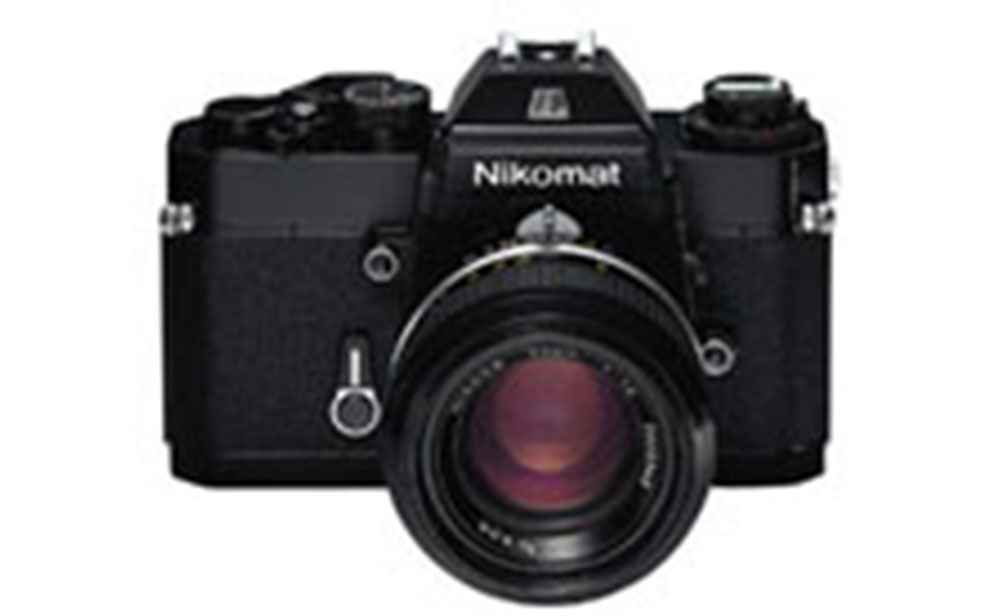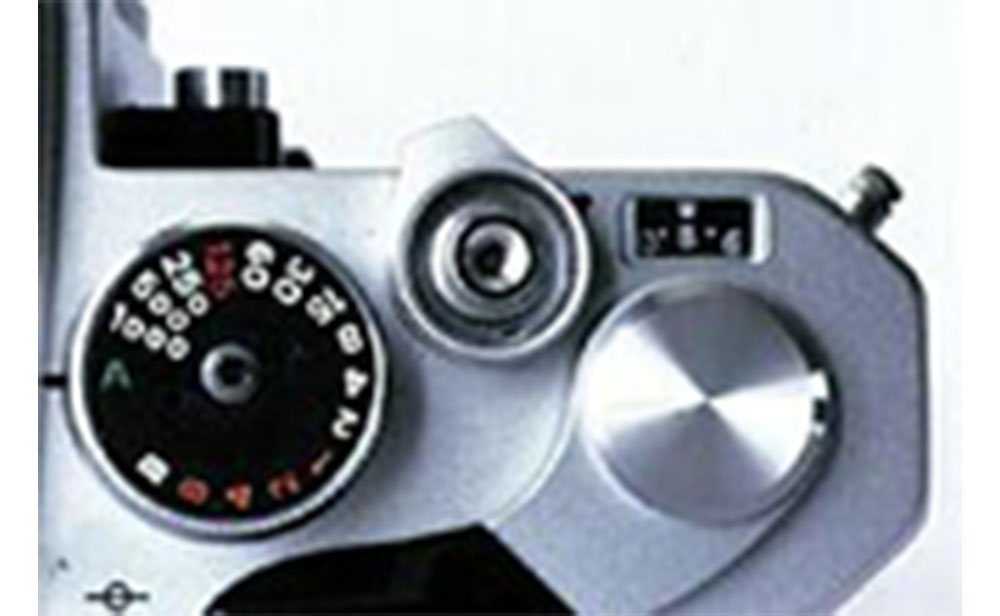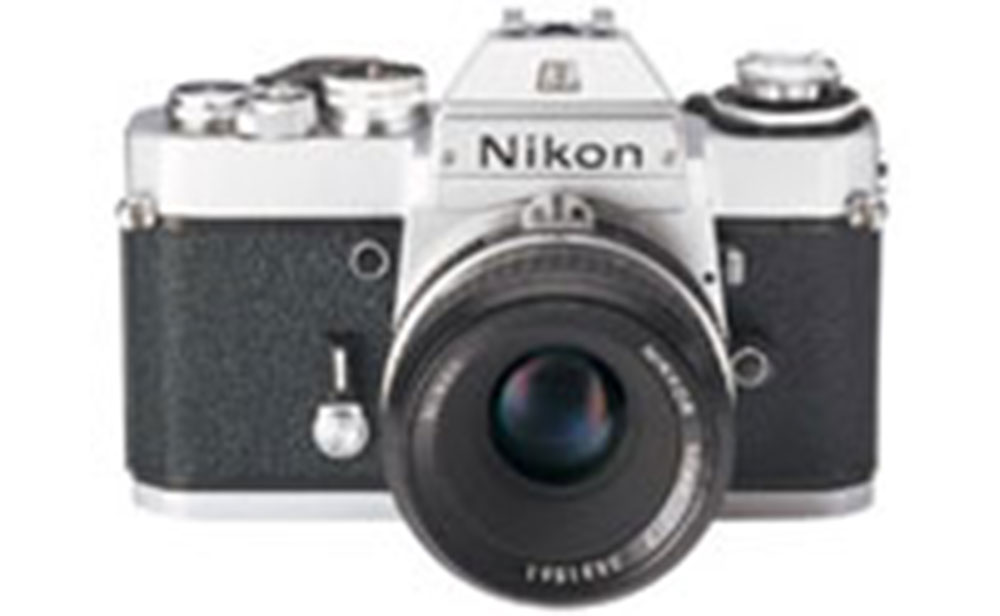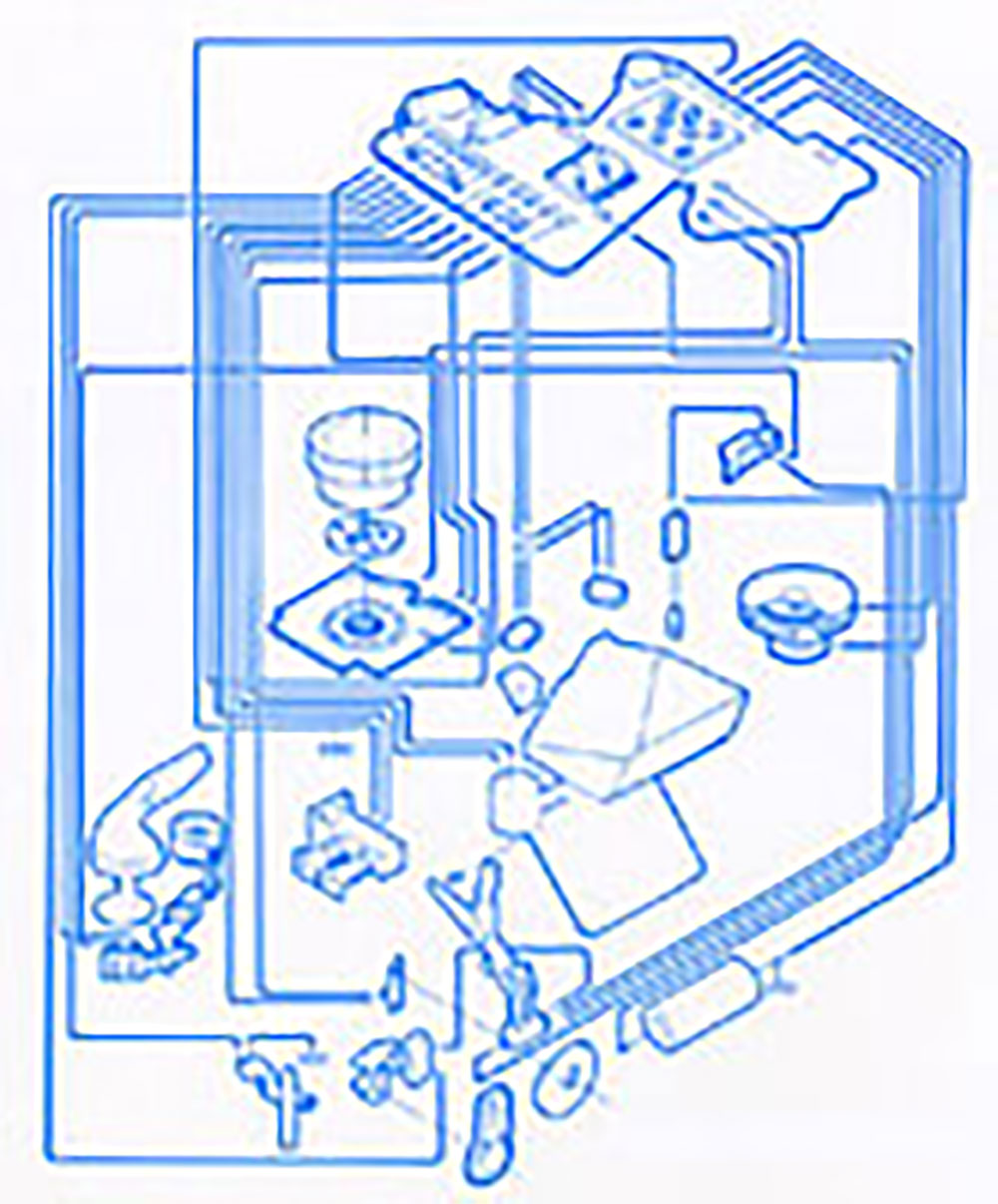Part 8 : "Nikomat ELW / Nikon EL2"
Nikomat ELW

Camera available only in black
Nikomat ELW was introduced in the early 1976 as a minor change model from the Nikomat EL (See Part 7.),which was released in 1972.
Some of you might remember that in April of that same year, "Canon AE-1" was released, together with "Power Winder A".
Its catch phrase in Japan(Nippon) was "Continuous Shooting SLR" and swept the camera market (it sold for a total of over 9 million cameras).
I, the author of this article, used to work in Nippon kogaku's designing department, felt a bitter feeling when asked by a sales representative of an electronic parts company "Isn't Nippon Kogaku K.K. going to make a "Continuous Shooting SLR"?"
It is because this sales representative was not aware of the fact that Nippon Kogaku was a "pioneer" regarding auto film-advance and continuous shooting, ever since the Nikon S2 or SP era.
Anyhow, around this time, winders and motor drives were prepared for SLR cameras as accessories.
The auto film-advance features became popular among the cameras. Nippon Kogaku's solution to the demands of the market at that time was this Nikomat ELW.
Plan from the Beginning
Nikomat ELW was a minor-change model, which attached the "Autowinder AW-1" to Nikomat EL.
The additional parts were the film-advance coupling at the bottom of the camera, electric contact point which transmits signal to start the film-advance, and a lock lever of a shutter release button ("shutter-button switch").
These features were passed on to the next Nikon EL2 (1977) as well.
Actually, there was already a plan to add automatic film winding mechanism to the Nikomat EL since the beginning of this project.
Unlike the motor drives in Nikon F or Nikon F2, it is designed to rotate the film-advance lever axle directly both ways.
But in order for the winding lever at the camera top not to rotate itself even when the film-advance lever is rotated from the camera bottom, it had to somehow link the two axles after separating the two.
Also, there was a plan to provide a full-scale motor drive which releases from the outside, e.g., by rotating the shutter button axle from the camera bottom.
But this idea was declined due to certain circumstance.
Autowinder AW-1
It is often argued that this AW-1 was the only product which Nikon named it "winder".
Different manufacturers make a distinction between a winder and motor drive one way or the other. Nippon Kogaku distinguishes if it is possible to shoot the picture continuously or not.
This "AW-1" is a "winder" since it can shoot only one frame at a time.
But speaking of the mechanism, the important thing is that it can wind the film automatically with a vertical square-type focal-plane shutter SLR camera, which is not a drum-type.
With this type of shutter, with reference to the charging, the film-advance axle cannot function by rotating in one direction only. It needs to be rotated both ways.
The driving mechanism developed here was also used for the later Motor Drive MD-11 and MD-12.
Dilemma of the electric switch
With the "Nikomat EL", the film-advance lever (stand-by position : 30 degrees) is used to switch the power ON and OFF, more commonly known as "film-advance lever switch".
Since the shutter of Nikomat FTN and Nikon F2 is mechanically controlled, the switch does not have to be turned ON at the time of shutter release.
However, with the electronically controlled Nikomat EL, the shutter speed is not controlled if the power is ON, thus when the power switch is OFF, the shutter button is designed to be locked.
In this connection, if there is no battery, the only mechanically controlled shutter speed, 1 / 90 sec., works.
The film-advance lever switch is effective with preventing to forget to turn the power OFF. It is because you can recognize either the power is ON or OFF, since it is near the position of the film-advance lever, which is a rather big parts of the camera (also, when putting the camera in the hard case and covering the front cover, you can prevent from forgetting to turn the switch OFF).
If it is a TTL-SLR camera that uses CdS for the photocell, you can put a cap on the lens (and the eyepiece) so that the light does not hit the photocell. By doing this the electric consumption will be less than micro-ampere, so you don't need to worry about turning the switch OFF.
However, with an electronically-controlled camera like the Nikomat EL that has a complicated electronic circuit, the story is different. Regardless of the intensity of the light which hits the photocell there is a constant flow of electricity by the order of milli-ampere (mA), so if with a small battery, it will die out in a few days.
Thus, with the Nikomat EL, the film-advance lever switch was important. It's a whole new story with Nikomat ELW or Nikon EL2, which can attach the autowinder. If film-advance is done by the winder, then there is no need of a lever. It is inconvenient to pull out the film-advance lever, which sticks out from the camera back, just to turn the power ON.
So, with the two models that can attach the autowinder, there is a small lever around the shutter button area, and this lever, the "shutter button switch" also functions as power ON / OFF switch and shutter button lock (See photo).
In order to use the autowinder, the "film-advance lever switch" is moved back flush to the camera body, and this "shutter button switch" becomes the ON / OFF switch.
Although this does not come in the way of film-advancing, a problem of forgetting to turn the power OFF has increased.

(The small lever around the shutter release button area : Photo of EL2)
There was a big dilemma where by making the power switch parts conspicuous it will reduce the chance of forgetting to turn the power OFF, but it becomes inconvenient when shooting.
If it is inconspicuous, then there will be more chance of forgetting to turn the power OFF.
This was a problem which continued until the "time switch", which goes off after a certain time lapse, was adopted to cameras like Nikon EM (1980) and Nikon F3 (1980).
Nikon EL2 and SPD

• Changed the photocell from CdS to SPD
• New exposure compensation ring (-1 to +2 step)
• Compatible to ISO 12 to 3,200 film
• Added 8 sec. to the shutter speed
• Synchro contact point became automatic
• Changed the shape of self-timer lever, which also works as exposure memory lever
In 1977, Nikon has changed the coupling system between the lens and camera body's exposure meter to a totally new AI (Automatic maximum aperture Indexing) system.
At that time Nikon F2 Photomic was replaced with Photomic A and Nikomat FT2 was replaced with FT3 (See Part 6.).
But also, the Nikomat EL and ELW was replaced with the AI system version Nikon EL2 (Photo Right).
Though Nikon EL2 at first seems like Nikomat ELW with AI system, which was originally a rangefinder system. However, most of the exposure system's circuits are being changed.
In the specification, it only says that the photocell has become from CdS to the more responding SPD (Silicon Photo Diode), but this change was significant.

Changing the photocell means changing the IC (Integrated Circuit). Since the electric current of the light of SPD is extremely weak, a new technology called the Bi-MOS system was used to make the IC (approximately 210 elements, including bi-polar transistor and MOS electric field effect transistors are compiled).
During the development of this Nikon EL2, the development of Nikon FE (1978) has already been decided.
It was understood from the beginning that the EL2 was not going to be released for that long.
So, in order to make the development efficient, Nippon Kogaku has done a good stunt. That was to use the same IC chip.
The Nikon EL2 and the Nikon FE uses totally the same exposure controlling IC.

Some of you might say that "why is it a stunt when the specification is almost the same ?".
Well, the difference is the power current. The EL2 uses only one 6-volt 4SR44 silver battery, and the FE also uses a silver battery, but uses two 1.55-volt SR44 battery.
Since the IC was going to be used for both models, the power voltage needed to be between 3-volt to 6 V ( the new batteries have higher voltage, and at the low temperature the battery voltage decreases, so it needs to be functional actually at wider range of voltage), and the IC manufacturers did as requested.
With the use of SPD, the number of electronic parts have increased, and it now used Flexible Printed Circuit (FPC) for the circuit board. Though it is quite common now, Nikon EL2 was the first camera, in which Nikon used this FPC for the circuit board.
The business result is quite uncertain with the effect of building the SPD to the EL2. However, from the CdS to SPD, and a hard and thick printed circuit board to FPC, the existence of this EL2 was great in a sense that it adopted the latest technology at the time of revolutionary changes with camera electronics.
One more thing. It is impossible to make the EL2 function with a 3 V battery. It is because it is made to function perfectly with the 6-volt, and the shutter magnet works only with a 6 V.
Note
This issue first appeared in "Nikkor Club Quarterly" magazine , published by the Nikkor Club, and was revised for Nikon's webpage.
Products, brands and companies names are trademarks or registered trademarks of their respective companies.
Camera Chronicle
Archives of corporate history subject matter related to Nikon cameras, including rare materials, as well as product photos of cameras and lenses.
